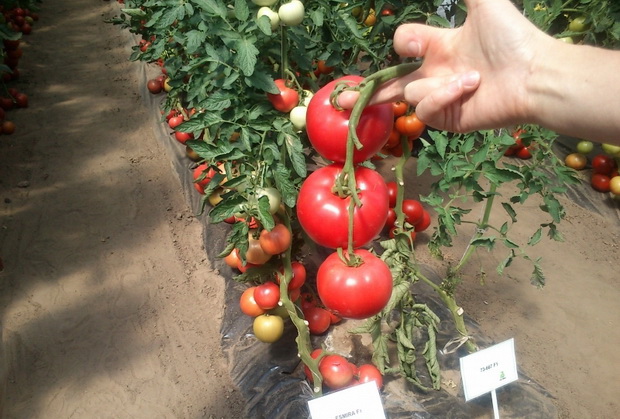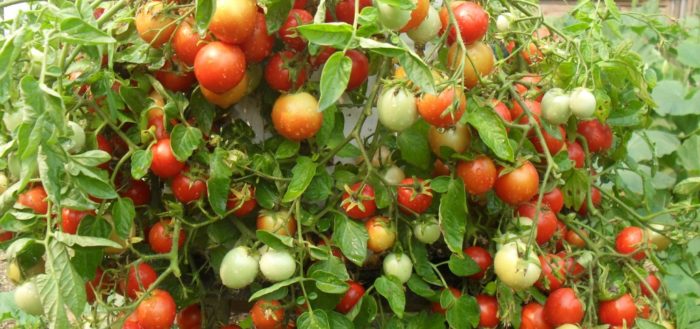Content:
The tomato variety Dar Zavolzhya has been known among gardeners for more than two decades. The popularity of this varietal variety of this fruit and vegetable crop is due to its remarkable gastronomic characteristics, high yield rates and unpretentious care. The date the variety was entered into the list of the State Register is 1992. Tomatoes Dar Zavolzhya are recommended for growing in open ground in all regions of our country.
However, despite the zoning of the variety, the most favorable regions for breeding are:
- Central Black Earth;
- North Caucasian;
- Nizhnevolzhsky.
Description of the variety
The shrub is not a standard shrub, it belongs to the determinant type. The average plant height is 80 centimeters. The positive side when caring for the planting is that during the development of the bush, it is not required to remove the apical part in order to limit the growth of the stem part. This tomato variety belongs to the mid-season category.
The stem of the bush is thickened, abundantly thickened with foliage. The size of each individual leaf is average, the color is light green, there is no pubescence, but the surface is wrinkled. The plant has a powerfully developed root system that grows in width with a radius of up to half a meter. Each brush forms 8 ovaries. Fruit formation on each cluster occurs evenly. Ripening of tomatoes is carried out at the same time. The weight of one tomato is about 100 grams. The shape of each individual fruit has a slight flattening, the surface is perfectly flat. The color of fully ripe tomatoes is red with an orange tint. The pulp has a dense consistency. The average number of seed chambers is 4.
The table purpose of these varietal tomatoes makes it possible to use them for the preparation of such types of culinary products as:
- salads;
- canned blanks;
- tomato juices.
The high yield of tomatoes from the Dary of the Volga region is due to the fact that the minimum amount of tomatoes that can be harvested from one shrub is 7 kilograms. However, to obtain such high results, it is necessary to provide the plant with ideal conditions. When germinating in unfavorable temperature conditions, the maximum crop weight will be 3 kilograms.
The gift of the Volga region is a variety of Russian selection, which was originally developed for the climate characteristic of the Caucasus and the Black Earth Region.
Since the cultivation of these varietal tomatoes was initially focused on the southern regions with a hot climate, it cannot be called frost-resistant. The gift of the Volga region is a medium-ripening variety. On average, the number of days from the germination of the first shoots to the start of harvesting is 105-110. The plant is included in the self-pollinated segment.
The average height of the bush is 80 centimeters. One tomato weighs about 100 grams. The shrub leaves are medium in size. A simple inflorescence is of the intermediate type. The first tab occurs over the 7th leaf, the subsequent ones - when every second leaf appears. The stalk has an articulation. The plant has a certain resistance to a number of diseases.
Tomatoes can be grown in a greenhouse with the following materials used for shelter:
- film;
- polycarbonate;
- glass.
Growing on an open bed is carried out when planting seedlings after the period of night frosts ends.
Recommendations for agricultural cultivation
The ideal soil type for this variety is black earth. In addition, the soil must be sufficiently moist and oxygenated.
The creation of ideal conditions allows you to grow a tomato bush in beds with soil of one of the following varieties:
- slightly loamy;
- sandy loam.
Sowing operations
The mid-March is considered a suitable time for sowing planting material. However, before starting sowing activities, it is recommended to prepare a pink solution of potassium permanganate in order to process the seeds in order to prevent the occurrence of foci of a number of diseases. Carrying out additional processing measures consists in soaking the seed for 2 hours in a solution with the addition of a drug that stimulates plant growth.
The soil material can be used for growing vegetables or for general purposes. It is not recommended to purchase budget substrates.
You can also make the landing land yourself. The procedure is as follows:
- Take ordinary garden soil;
- Add compost or peat to the garden soil;
- Add sand to the resulting earthen mixture;
- Add superphosphate (lighten the soil if necessary).
Plant the treated seeds at a depth of two centimeters, keeping the same distance between adjacent plantings. Fresh plantings should be watered using a spray bottle to avoid soil erosion. After watering, future sprouts must be covered with one of the available materials:
- transparencies;
- glass.
In order for seedlings to appear on time, the following conditions must be met:
- abundant sunlight;
- maintaining a constant temperature.
The preferred place for germination of seedlings is the southern windowsill, where drafts do not have access.
How to transplant to an open ridge
May is suitable for planting tomatoes in open ground, since the risk of returning night frosts at this time is minimal. For transplantation into a heated greenhouse, this period is postponed several weeks earlier.
Before planting, the seedlings must be hardened. To carry out this procedure, in the daytime, when warm weather sets in, the plants must be taken out into the open air for 2 hours, gradually increasing the number of hours of hardening to a whole day.
When transplanting to a permanent place, it is necessary to observe a 40 cm distance between adjacent plants and 60 cm between rows. A handful of compost or peat, a small amount of mullein or complex fertilizer should be added to the prepared depression.
A slightly buried root, placed in a hole, must be watered and covered with soil. There is no need to tamp the soil in the root area.When ensuring air permeability of the soil, the presence of swollen areas should be avoided.
List of advantages and disadvantages
The positive characteristics of the Dar Zavolzhya tomatoes, in comparison with other varieties, are:
- Almost 100% seed germination rate;
- Easy transfer of the pick;
- No difficulty in transplanting to a permanent place;
- Lack of complex procedures to ensure agricultural cultivation;
- Ripening tomatoes at the same time;
- High productivity;
- Subject to moderate watering, ripening fruits do not crack;
- Positive characteristics of gastronomic properties;
- Ability to store for a long time;
- Good presentation;
- Resistance to a number of diseases;
- Versatility of application.
The disadvantages of the variety are:
- Sour taste of fruits with excessive watering;
- Lack of resistance to temperature extremes;
- Deformation of the plant when exposed to strong winds.
The Tomatoes of the Volga Region, widely known among Russian summer residents, are a variety that has excellent taste. On the territory of our country, this type of the described fruit and vegetable crop has been successfully grown for more than two decades. For many vegetable growers, the Dar Zavolzhya tomato is a must on the list for annual cultivation.














